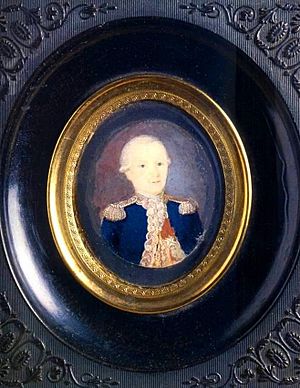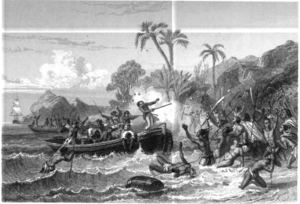Paul Antoine Fleuriot de Langle facts for kids
Quick facts for kids
Paul Antoine Fleuriot
Vicomte de Langle
|
|
|---|---|

Miniature portrait of Fleuriot de Langle
|
|
| Nickname(s) | Fleuriot de Langle |
| Born | 1 August 1744 Kerlouët castle |
| Died | 11 December 1787 (aged 43) Tutuila |
| Buried |
Choir of Saint-Louis Church, Brest
|
| Allegiance | Kingdom of France |
| Service/ |
French Royal Navy |
| Years of service | 1758 – 1787 |
| Rank | Rear-Admiral |
| Commands held | Experiment Astrée Astrolabe |
| Battles/wars | Hudson Bay expedition |
| Awards | Knight of the Order of Saint Louis Society of the Cincinnati |
Paul Antoine Fleuriot de Langle (born August 1, 1744, at Kerlouët castle in France – died December 11, 1787, in Samoa) was a French nobleman, naval officer, and explorer. He was second-in-command of the famous La Pérouse expedition. This journey began on August 1, 1785, and sadly, the expedition was eventually lost in the Pacific Ocean. Fleuriot de Langle died during a conflict with local people in what is now American Samoa before the rest of the expedition disappeared. His body was later returned to France and buried in a church in Brest.
Contents
Paul Antoine Fleuriot de Langle showed great talent from a young age. In 1771, when he was just 27 years old, he became a member of the Académie de Marine, which is like a special academy for naval officers and experts. He was promoted to Lieutenant in 1778, showing his progress in the French Royal Navy.
Fighting in the American Revolutionary War
Fleuriot de Langle played a part in the American Revolutionary War. In April 1781, he was given command of a 32-gun warship called the Résolue. Later, in March 1782, he commanded a larger 50-gun ship named the Experiment. He also commanded the frigate Astrée during the Hudson Bay expedition. In this expedition, he served under the command of La Pérouse.
The La Pérouse Expedition
La Pérouse chose Fleuriot de Langle to be his second-in-command for a new and important expedition. This was because Fleuriot de Langle was known for his skills, his knowledge of math and astronomy, and his strong character. He commanded the ship Astrolabe, which had 114 crew members. The Astrolabe sailed alongside another ship, the Boussole, on a long journey of exploration into the vast Pacific Ocean.
A Stop in Samoa
In 1787, during the return journey, the crew started to suffer from scurvy. This was a serious illness caused by a lack of fresh food. To find fresh water and food, Langle and La Pérouse decided to land on the Samoan island of Maouna. Both officers knew how important fresh food was to prevent scurvy. Langle also believed that fresh water was helpful, a lesson learned from the famous explorer Captain Cook.
Their boats were filled with water barrels, and they waited for the tide to be high enough to return to their ships. However, many local people gathered on the beach. The situation became very tense and confusing.
Conflict and Tragedy
To try and calm things down, Fleuriot de Langle offered some small gifts to the local chiefs. This helped for a moment, but soon, thousands of local people surrounded the boats. They stopped the French sailors from getting back to their ships. Langle did not want to fire on them because the French king had ordered the mission to be peaceful.
Sadly, Langle was hit by a stone and fell into the water, dying instantly. After this, his sailors had to open fire to defend themselves. In the terrible fight that followed, 12 sailors were killed, and 20 more were injured.
Legacy
After his death, Paul-Antoine Fleuriot de Langle was given a higher rank, Chef de Division, on April 24, 1788. La Pérouse spoke highly of his friend, saying that Langle "died for his humanity." He also said, "I have lost by the most horrific of treasons my best friend, my friend for thirty years. A man full of spirit, judgment, knowledge, and certainly one of the best officers in all the fleets of Europe." Langle's remains were buried in the church of Saint-Louis in Brest.
There is a monument on the island of Tutuila in American Samoa that honors Paul-Antoine Fleuriot de Langle and the other sailors who died there. It was built in 1883 and says, "Inaugurated in 1883 to honor the memory of de Langle and the 11 other members of the Lapérouse expedition massacred on this site."
In 1999, an archaeological team explored the shipwrecks of the Boussole and Astrolabe near Vanikoro. They found a silver fork with Fleuriot de Langle's family symbol on it, which was an amazing discovery.


